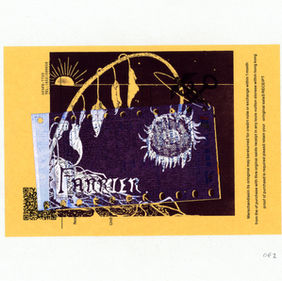Phantom of the Road
Samuel Farrier |
February 15 - April 5, 2025
















































In 1930 a typeset book was published in Bruxelles in an edition of 850. This
volume titled Le Faux Van Gogh detailed known ‘fake’ Van Gogh’s of the time.
Dimensions and descriptions are supported by a mass of black and white plates
juxtaposing images of these ‘fakes’ with their ‘original’ counterparts.
Years ago while in Antwerp I splurged on a copy of my own having encountered it
floors up in an old book shop locked behind the loose tracked sliding glass of a
vitrine. There it was, central, aged olive green with aubergine cover text, winged by
a very old copy of Vico’s Scienza Nuova (The New Science) and a well-loved title
on vanitas of the Dutch baroque. Thumbing through the mold speckled pages of Le
Faux Van Gogh, I can’t help but giggle at the notion of indexing falsity.
Van Gogh was not only copied but he copied. Some unusual examples are his three
canvases in oil depicting enlarged compositions of Eisen and Hiroshige ukiyo-e
wood blocks from the floating world in Edo Japan.
In his famed series, the sunflowers of Arles, he copied compositions of his own. A
pair was painted in 1888 to hang above Gaugin’s bed during his stay in the yellow
house. Of the seven in this series, two are initial studies. The remaining five consist
of only two compositions. Today you can see Van Gogh’s ‘original’ painting
Sunflowers hanging in London’s National Gallery, or you can go see Sunflowers in
Amsterdam’s Van Gogh museum or should you be in Tokyo you can find Van
Gogh‘s ‘original’ painting Sunflowers at the Sompo Museum of Art.
The latter is frequently cited as faux though I don’t think it much matters. Sompo
Japan Insurance Inc. purchased it from Christie’s London in 1987 for just shy of 40
million dollars and the Van Gogh Museum in Amsterdam currently lists Sompo
Japan Insurance inc. as a founding partner for its recent patronage in the realization
of a new entrance hall.
All of these Sunflowers are done in an early synthetic pigment, known as chrome
yellow which has a tendency to darken with exposure to light. Fascinatingly, when
you stand in front of Van Gogh’s ‘original’ painting Sunflowers in London,
Amsterdam or Tokyo you witness a dignified shade I would liken to French Ochre
not the hot and hectic synthetic chrome yellow as it was freshly painted in La Belle
Époque.
This evanescence of the synthetic is of perineal interest when reviewing artwork
that blossomed in the eras of Impressionism - Post and really, ever since. Given
time our relationship to the synthetic has only deepened and now that the cork is
popped, synthesis flows whether one thirsts for it or not.
This phenomenon is familiar today in the sun bleaching of plastic bags, aging of
paints, the micro plastics in your liver and a mounting confidence that the world is
no longer encountered, discovered or unwrapped but hurriedly invented.
Advancements are made and time trundles on.
Atop a small mountain in Southern California, on view at The Getty Center in Los
Angeles is Ultra-violet: New Light on Van Gogh’s Irises. This exposé of one
‘original’ painting and a copy of it inspired by its ‘original’ appearance
investigates Van Gogh’s use of the fugitive pigment geranium lake.
X-ray fluorescence (XRF) images show the blooms, close up, in nearly inverted
color like a limber deer through the night vision crosshairs of a squinted site.
Given a century + to bathe in the sun, an effervescent lake of geranium evaporates
and the blossoms once violet are now blue. Shortly after my visit last December,
the internal threat that material composition holds to immutability was rivaled by
the near Pompeiian instability of the external.
I am told that Painting is a plastic art, which is characterized by the practice of
applying paint, pigment, color or other medium to a solid matrix.
Painted representations frequently outlive their subjects. The hardened oil eternally
in bloom. These warped phantoms mirroring what once was, a copy of something,
sometime, somewhere.
It would seem that if vanitas was for the living and Edo was floating, surely, we
are painted.
Samuel Farrier (b. 1989), is a New York based artist and founder of The
New York Board of Taste, a contextual archive in lower Manhattan specializing in
unlikely collaborations and small publishing.Farrier has been an artist in residence at The Elizabeth Foundation, NewYork (2017). Las Huertas, Cortez, CO (2019) and L’apartmento, Naples Italy(2022). Select group shows include: (Maria VMier) No: tongue breaks and thin
fire is racing under skin, Museum Brandhorst, Munich Germany 2024. The Flower
Thief, The Meeting, New York, 2024. Fixture, Soloway, Brooklyn, 2023. Mura
Bellini, Taschino, Naples Italy, 2022. Rubus Armeniacus, Jessica's Place, New
York, 2019. Superhuman, Fisher Parish, New York, 2018. Hectare, Demain, Paris,
France, 2018. 36 hours, Particulier, New York, 2017.